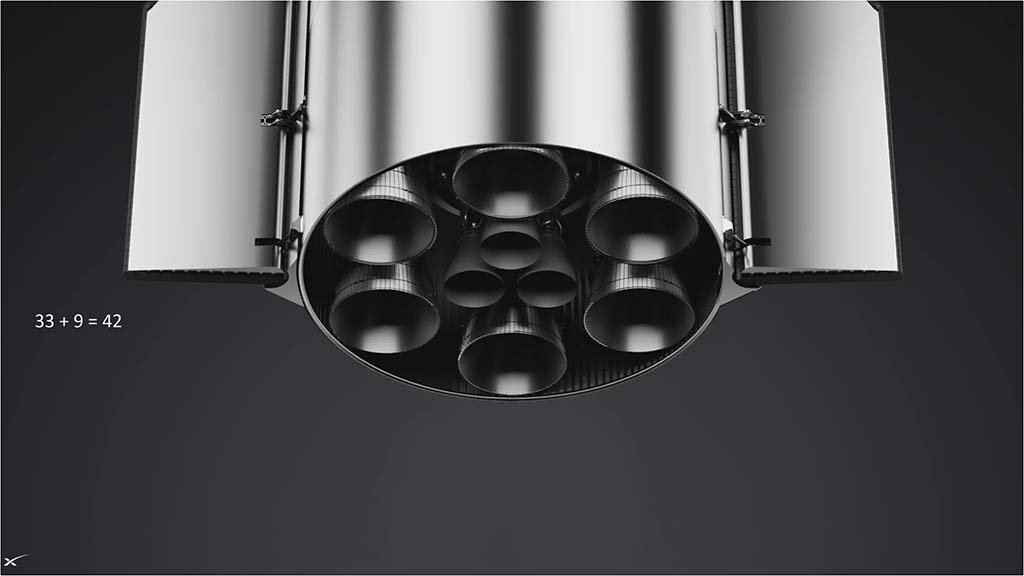SpaceX founder Elon Musk said the next major Starship upgrade—“Version 4” (V4)—will expand the vehicle to 42 Raptor engines, targeting first flights around 2027 to support larger Mars-bound payloads. The configuration adds engines to a longer ship and builds on the current 33-engine Super Heavy booster.

If implemented, a 42-engine stack could materially increase liftoff thrust, engine-out redundancy, and payload margins, cornerstones for orbital refueling and eventual interplanetary missions. The move also signals that SpaceX is iterating toward a higher-capacity Block/Version roadmap—an approach validated by independent reporting that the Block 3 Ship may grow to nine engines, bringing the stack total to 42 when paired with the 33-engine booster.
What Musk revealed
Musk posted that Starship V4 will be “significantly longer” and carry 42 Raptors, achieved by adding three more engines to the upper stage relative to current designs. He also joked about the Douglas Adams–style symbolism of “42,” but tied the number to practical goals: more thrust and better margins for deep-space missions. Target: 2027 for V4 flight testing.
Where things stand today
As of mid-2025, the Super Heavy booster flies with 33 Raptor engines, while the Starship upper stage has six (three sea-level, three vacuum). That architecture powered the most recent integrated tests, even as SpaceX works through reliability issues and upgrades between flights.
Independent reporting on engine counts
A detailed NASASpaceflight analysis anticipates a Block 3 Starship with nine engines on the ship itself, citing a switch to Raptor 3 and a reusable payload upward of ~100+ tons—aligning with a combined 33 + 9 = 42 engines across the stack. While Musk’s “V4” phrasing and NSF’s “Block 3” label aren’t identical, both point to a higher-thrust, higher-redundancy Starship evolution.
Why 42 engines matter
- Thrust & margin: More engines increase total liftoff thrust and engine-out capability, crucial for abort resistance and performance in heavy payload or tanker roles.
- Refueling cadence: Higher payload to orbit can reduce the number of tanker flights needed to fully top up a Mars-bound ship, simplifying mission risk.
- Manufacturing throughput: The plan leans on SpaceX’s Raptor production improvements (e.g., Raptor 3), aiming for higher chamber pressures and simplified build to bring cost per engine down—vital when scaling to dozens per vehicle.
Program context and recent flight activity
Starship’s 2025 campaign has mixed results, with Flight 9 in late May pushing objectives despite earlier failures, and Flight 10 recently standing down over a ground-side LOX issue before a planned attempt—illustrating the iterative nature of testing while infrastructure and engines mature.
What’s next—milestones, timelines, guidance
- Near-term tests: SpaceX is targeting the next integrated flights as it resolves ground-system issues and continues engine/avionics upgrades; schedules remain fluid pending readiness and FAA approvals.
- Block/V4 transition: Expect one or more final “Version 2” flights before SpaceX shifts focus to the upgraded vehicle with more powerful engines and structural tweaks, per industry reporting.
- Beyond Earth orbit: The 42-engine path interlocks with orbital refueling demos and cargo mass growth, prerequisites for credible Mars mission architectures later in the decade.
According to Elon Musk’s posts on X outlining a 42-engine Starship V4 and a 2027 flight target and NASASpaceflight’s technical reporting on a Block 3 Ship with nine engines (total 42 when combined with the 33-engine booster). Additional current-state engine counts and flight-test context from Ars Technica, with near-term schedule updates from Teslarati and Reuters.
- Musk on X: “Starship will have 42 engines.” (June 16, 2025) and V4/V3 notes.
- NASA Spaceflight: “Future of the Starship Program, Block 3 and Mars.” (May 30, 2025).
- Ars Technica: Starship stack currently has 33 + 6 engines and an upgrade cadence. (Aug 15, 2025).
- Teslarati/Reuters: Flight 10 stand-down and re-targeting. (Aug 24–25, 2025).
Conclusion
The 42-engine concept is not just a memeable nod to “the answer to life, the universe, and everything”—it’s a scaling strategy. By lifting thrust, redundancy, and payload, SpaceX aims to compress the logistics of on-orbit refueling and Mars cargo delivery, two pillars of a sustainable interplanetary program. The plan remains prospective until hardware flies, but the direction is clear: iterate the vehicle, multiply engines, and push toward the payload and reliability thresholds that make routine deep-space operations plausible later this decade.











